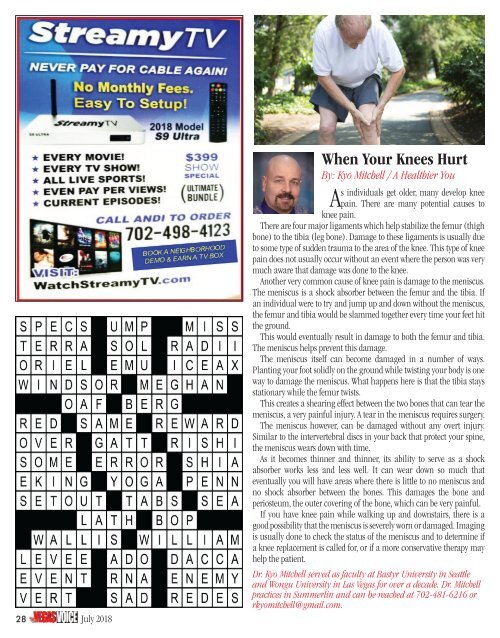You also want an ePaper? Increase the reach of your titles
YUMPU automatically turns print PDFs into web optimized ePapers that Google loves.
28<br />
July 20<strong>18</strong><br />
When Your Knees Hurt<br />
By: Kyo Mitchell / A Healthier You<br />
As individuals get older, many develop knee<br />
pain. There are many potential causes to<br />
knee pain.<br />
There are four major ligaments which help stabilize the femur (thigh<br />
bone) to the tibia (leg bone). Damage to these ligaments is usually due<br />
to some type of sudden trauma to the area of the knee. This type of knee<br />
pain does not usually occur without an event where the person was very<br />
much aware that damage was done to the knee.<br />
Another very common cause of knee pain is damage to the meniscus.<br />
The meniscus is a shock absorber between the femur and the tibia. If<br />
an individual were to try and jump up and down without the meniscus,<br />
the femur and tibia would be slammed together every time your feet hit<br />
the ground.<br />
This would eventually result in damage to both the femur and tibia.<br />
The meniscus helps prevent this damage.<br />
The meniscus itself can become damaged in a number of ways.<br />
Planting your foot solidly on the ground while twisting your body is one<br />
way to damage the meniscus. What happens here is that the tibia stays<br />
stationary while the femur twists.<br />
This creates a shearing effect between the two bones that can tear the<br />
meniscus, a very painful injury. A tear in the meniscus requires surgery.<br />
The meniscus however, can be damaged without any overt injury.<br />
Similar to the intervertebral discs in your back that protect your spine,<br />
the meniscus wears down with time.<br />
As it becomes thinner and thinner, its ability to serve as a shock<br />
absorber works less and less well. It can wear down so much that<br />
eventually you will have areas where there is little to no meniscus and<br />
no shock absorber between the bones. This damages the bone and<br />
periosteum, the outer covering of the bone, which can be very painful.<br />
If you have knee pain while walking up and downstairs, there is a<br />
good possibility that the meniscus is severely worn or damaged. Imaging<br />
is usually done to check the status of the meniscus and to determine if<br />
a knee replacement is called for, or if a more conservative therapy may<br />
help the patient.<br />
Dr. Kyo Mitchell served as faculty at Bastyr University in Seattle<br />
and Wongu University in Las <strong>Vegas</strong> for over a decade. Dr. Mitchell<br />
practices in Summerlin and can be reached at 702-481-6216 or<br />
rkyomitchell@gmail.com.

















